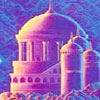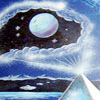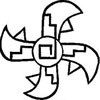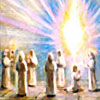The Sleeping Prophet On Lemuria ~ Part II
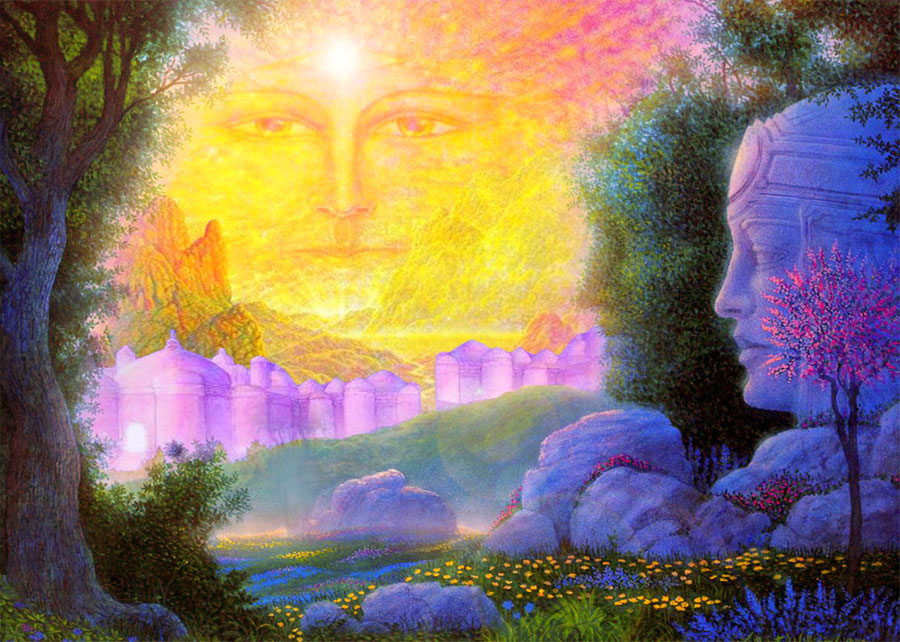 by Frank Joseph
by Frank Joseph
Most of Cayce’s recorded statements about the lost Pacific kingdom follow its people to other parts of the world. During his life reading of April 17, 1936, Edgar Cayce told of immigrants from a global catastrophe arriving in the Near Eastern “lands of Zu.”
Interestingly, Har-Sag-Mu was known 5,000 years ago as “Mu of the Mountain Range,” where Zu, the Sumerian sky-god, settled after causing a terrible cataclysm. Thereafter, “stillness spread abroad, silence prevailed.” In the later Babylonian version, as preserved in the Assyrian library of Ashurbanipal, Zu stole the Tablets of Destiny from his fellow gods and brought them to Har-Sag-Mu. His self-transformation into a bird of prey to fight off a serpent guarding the tablets recurs in worldwide imagery of an eagle battling a snake, from the Greek Delphi and Norse Yggdrasil to Aztec Mexico and pre-Columbian Colombia.
Zu’s myth is also associated with the chakra system of spiritual conflict between the kundalini serpent wound around the base of the human spine and Garuda, the eagle of an enlightened crown chakra. The myth implies that this metaphysical concept was brought directly from heaven to Har-Sag-Mu, a sacred mountain on the Pacific island of Mu. Zu’s theft of the Tablets of Destiny, which first described kundalini yoga, parallel the Western myth in which the brother of Atlas, Prometheus, stole fire from the gods and gave it to humankind. That “Promethean heat” appears to have been no less analogous to kundalini energy, because the Greek Titan suffered the daily digestion of his liver by an eagle.
Cayce portrays the people of Mu as far-ranging travelers, sailing mostly to Peru, but also to Yucatan and the American Southwest, as far afield as the Nile Valley, and even Atlantis. They went there, Cayce said, mostly to study the sciences, of which alchemy was one he singled out for special mention (274-1 M.34 2/13/33). The Lemurians apparently left something of themselves behind, because their religious ideas made converts among the spiritually divided Atlanteans (1273-1 M.40 10/16/36).
Atlantis was to suffer four natural catastrophes, each one sparking waves of migration to other parts of the world, before the final destruction. Survivors from all of these calamitous events, save the last, sometimes sought sanctuary in the Pacific kingdom, perhaps because it was so far removed from the geologic violence of the mid-Atlantic world, or due to ancient kindred ties of common spirituality with the gentle Lemurians. Describing a client’s past life as an Atlantean refugee during one of these upheavals, Cayce remarked, “The entity was among the last to leave for what was then Mu” (557-2 F.52 5/23/34).
Indeed, relations between the two widely separated oceanic civilizations may have been more than cordial, at least in a few instances. Cayce refers to a half-Lemurian, half-Atlantean as Mufuti (2850-1 M.18 11/14/42), and a female spiritual adviser in Atlantis was Muglo (2454-3 F.43 7/15/42). He mentions an Atlantean ruler in Yucatan with the distinctly Lemurian name of Zurumu (1632-3 F.38 8/9/38). These hybrid Atlanto-Lemurian personal names are complemented by identifiably Atlantean place-names and ancient heroes or gods found throughout numerous Pacific island cultures.
According to the Tanimbar Austronesian people of southeast Maluku, Atuf separated the Lesser Sundras from Borneo by wielding his spear while traveling eastward with his royal family from a huge natural cataclysm that annihilated their distant homeland. It supposedly took place at a time when the whole Earth was unstable. The chief cultural focus of the Tanimbar is concentrated on the story of Atuf and his heroism in saving their ancestors from the disaster.
“Thereafter they had to migrate ever eastward from island refuge to island refuge,” writes Oppenheimer. “As if to emphasize this, visitors will find huge symbolic stone boats as ritual centers of the villages.” North of Maluku, a similar account is known to the islanders of Ceram and Banda. In their version, their ancestors are led to safety by Boi Ratan, a princess from the sunken kingdom.
Profound impressions were likewise made in early pharaonic Egypt, where at least two important gods revered during dynastic times bear the stamp of Lemurian influence. Temu is described by archaeologist Anthony Mercatante as “the oldest of the creation gods in Egyptian mythology.” Temu was an undersea deity, dwelling in the primeval ocean he brought about. His thoughts made the heavens, animals, plants, mortals, and the gods themselves, who were expressions of his will. He was responsible for a catastrophic deluge that long ago covered the entire face of the globe, destroying all life, except for a few virtuous men and women who joined the gods in a “solar boat.” Landing at the Nile Delta, they began civilization anew. Appropriately, the ancient Egyptian word for ocean was Mu. Beyond Temu’s self-evident name, his myth implies the arrival in Egypt of culture bearers from Mu, which suffered several major flood events. In later dynasties, his name changed as a consequence of large-scale immigration from Atlantis, and he was known henceforth as Atmu.
Another Lemurian deity worshiped throughout the Nile Valley from a very early period was Khnemu. His name means literally “the Molder,” because he shaped the cosmic egg, from which all life hatched during remote prehistory. This was the omphalos, or navel stone, a leading symbol of Atlanto-Lemurian spirituality. Khnemu was portrayed in temple art with the body of a man sprouting four ram heads. These signified the dissemination of his navel-of-the-world cult from its place of origin across every sea to the four cardinal directions; the ram has, since ancient times and in many cultures, personified oceanic voyagers. Khenmu’s popularity was so deeply rooted that his veneration continued well into the second century A.D., when gnostic gems bearing his image were still being made. The worship of these two gods from the beginning of Egyptian civilization supports Cayce’s contention that adepts from Mu contributed to the foundation of its powerful religion (1353-1 F. Adult 3/26/37; 2697-1 M.48 3/11/42).
Some of the overseas immigrants he described bore unmistakably Lemurian names, like Shu-Su-Mu-Lur-R (1695-1 F.32 9/29/38) and Mu-Elden (2513-1 F.70 6/12/41). As representatives of the old mystery-cult, they attended the completion of the Great Pyramid at the Giza Plateau. This was accomplished when “the crown or apex . . . of metal that was to be indestructible, being of copper, brass and gold with other alloys,” was fixed to its summit. The “Earth building,” as he referred to the pyramid, functioned in part as a place of spiritual transformation and initiation.
According to Cayce, its official opening set an unremembered precedent for similarly spiritual events in the future. “The ceremony was long,” he recalled, “the clanging of the apex by the gavel that was used in the sounding of the placing. Hence, there has arisen from this ceremony many of those things that may be seen in the present; as the call to prayer, the church bell in the present may be termed a descendant . . . the sound as of those that make for mourning, in the putting away of the body; the sounding as of ringing in the new year, the sounding as of the coming of the bridegroom; all have their inception from the sound that was made that kept the earth’s record of the earth’s building.” (378-14 M.56 9/26/33)
Cayce said a last impact was made on the American Southwest, “in particular that portion of Arizona and Nevada that [is] as a portion of that brotherhood of those peoples from Mu” (812-1 F.48 2/4/35). Cayce told how a client, in a former Lemurian incarnation, journeyed to what is “now known as Arizona and Utah . . . those portions that were then a place of refuge from Mu” extended as far as Missouri (816-3 M.51 2/17/35).
These states are especially pertinent to our discussion of Lemuria, because the tribal peoples who have inhabited them for time out of mind preserve rich oral traditions of the vanished Pacific civilization. For example, the Ute Indians, who gave their name to the state of Utah, revere Mu-sinia as their sacred white mountain. It is among the Hopi and Zuni in Arizona and Nevada that tribal accounts of ancestral wanderings from the Pacific Ocean are well preserved in oral tradition and ceremonial ritual. Both are combined in annual dramas reenacted at the kiva, a circular structure built over a subterranean chamber connected by a ladder. As initiates emerge from the underground room, they are doused with copious amounts of water by fellow participants loudly reminding them of the terrible deluge their forefathers escaped in the distant past.
Cayce’s special reference to southern California for its Lemurian past is particularly underscored by the testimony of its native peoples (1473-1 F.49 11/10/37; 5750-1 Hugh Lynn Cayce 11/12/33). According to California’s Salinen Indians, humanity perished in a world flood. Only a single diving bird survived. It dove deep into the ocean and fetched up a beak-full of muck from the bottom of the sea. Seeing this performance, Eagle God descended from the sky to fashion a new race from the retrieved mud.
The Washo are native Californians who recounted an early golden period of their ancestors. For many generations, they lived in happiness on a far-off island, at the center of which was a tall stone temple containing a representation of the sea god. His likeness was so huge that its head touched to the top of “the dome.” It seems remarkable that the Washo, whose material culture never exceeded the construction of a tepee, would have even known about an architectural feature as sophisticated as a dome. Their deluge story tells of violent earthquakes that caused the mountains of their ancestral island to catch fire. The flames rose so high they melted the stars, which fell to Earth, spreading the conflagration around the world. Some plummeted into the sea and caused a universal flood that extinguished the flames but threatened humanity with extinction.
The Wintun tribe of California told of a shaman who stole the magic flute of Katkochila, the sky-god. With this instrument, he could make his people the most powerful in the whole world. Katkochila, in a rage, showered the Earth with fire from heaven but doused the conflagration before humanity was exterminated.
In the Wiyot tribal account of Above-Old-Man, the Creator (Gudatri-Gak-witl) sent a worldwide flood to extinguish humankind and most animals. Condor survived to find only his sister, a few birds, and a single raccoon left alive. A new humanity was born from his incestuous relationship. Wiyot customs mandated that a chief take his sister as bride, if only ritually, to commemorate his people’s descent from the ancestral pair that escaped the Great Flood.
Southern California’s Yokut Indians recount that humankind was born on an island in the middle of a primeval sea. Here Eagle and Coyote fashioned the first men and women.
Volcanic Mount Shasta is described in several local Indian myths as the only dry land to have survived a worldwide flood. Building a raft, Coyote-Man sailed over great expanses of water to arrive at its summit. There he ignited a signal fire that alerted other survivors, who came to Mount Shasta, from which they repopulated the Earth. Into modern times, mysterious lights sometimes seen on the mountaintop are associated with ceremonies of a Lemurian brotherhood, whose initiates allegedly perform rituals from the lost civilization.
Lemurian influences dominated the development of Mesoamerican civilization until waves if immigration arrived from the east. “There had been the upheavals also from the land of Mu, or Lemuria,” Cayce said, “and these had their part in the changing, or there was the injection of their tenets in the varied portions of the land—which was much greater in extent until the final upheaval of Atlantis.” (5750-1 Hugh Lynn Cayce 11/12/33). His statement reflected in the Mayan word for flood: mu-luc, literally, “drowned Mu” or “drowned like Mu.” Mu-tul was a Mayan city founded by Zac-Mu-tul, whose name means, “the white man of Mu.” Mu-tul seems philologically related to the Polynesian Mu-tu (Tahiti) and Mu-tu-hei (Marquesas), all defining a Lemurian common denominator.
The deluge-hero of the Caribs (who gave their name to the Caribbean Sea) was “the man from Mu.” Described as a fair-complected, light-haired and -bearded sorcerer, Ta-Mu escaped a natural catastrophe at sea. The Caribs compared their sixteenth-century Spanish conquerors to Ta-Mu. A similar flood survivor was known to the Arovac Indians. They remembered Ca-Mu, “he from Mu,” as a tall, white-skinned, fair-haired and -bearded magician who arrived on the shores of Panama after having been driven from his kingdom far across the sea by a terrible cataclysm. Ca-Mu is regarded as the man from whom all Arovac have since descended.
When Cayce said that “the Andean, or the Pacific coast of South America, occupied then the extreme western portion of Lemuria,” he accurately portrayed the extent of its influence, which appears to have spanned the islands between Japan and the shores of Peru (364-13 11/17/32), for Mu or Lemuria was not so much a specific land as it was a people and their culture spread over a number of territories more or less connected to each other across thousands of miles.
Cayce’s particular life reading is supported by a wealth of physical evidence among the extensive ruins of Chan Chan, just north of the Spanish colonial Peruvian city of Trujillo. It was the pre-Inca capital of the Chimu, with numerous other philological references to the vanished Motherland of Mu. Chan Chan had been built, the Chimu recounted, at the behest of “a great lord from across the sea.” Its founding father was Taycanamu, followed by another culture bearer, Pacatnamu. These important names must have been derived from the sunken city actually depicted on the abode walls of Chan Chan’s Palace of the Governor. The monumental mural still portrays a long line of step-pyramids with fish swimming over their summits, obviously depicting a sunken city, perhaps that of Taycanamu’s “great lord from across the sea.” His story compares with Hotu Matua’s account of having been ordered away from Marae Renga by his superior before Hiva sank into oblivion.
This evocative imagery appears to depict Colombian native traditions of a great oceanic kingdom destroyed by some natural catastrophe from which the culture hero A-Mu-Ra-Ca led his followers to South America. In Akkadian, the language of Sumer’s Semetic conquerors at the close of the third millennium B.C., A-Mu-ruu means “western lands.” The name, in both Colombian Muysica and Akkadian, refers to the lost Pacific Ocean civilization of Mu. A related flood account was current at the time of the Spanish conquest among the Karaya Indians, whose ancestors were led by Kaboi into a massive cave as a place of refuge. After the waters retreated, they followed him back into the world and were guided by the song of a bird. This bird motif recurs in several deluge traditions around the world, not only in Genesis. Kaboi is known throughout South America, referred to as Ka-mu by the Arawaks, Tamu by the Caribs, Kame by the Bakairi, and Zume by the Paraguayans.
Of Lemuria’s demise, Cayce said little, except that it took place before the final destruction of Atlantis. He was more concerned with the implications of the Pacific kingdom’s peaceful accomplishments, which continued to shape the reincarnated lives of men and women seeking his spiritual guidance. Karma is the consequence of our behavior, he explained. By striving for social balance and individual harmony, the Lemurians largely avoided any need for reincarnation as a means of correcting the consequences of former indiscretions and went on to fulfill their spiritual destiny in levels of being beyond the Earth plane.
Excerpt from The Lost Civilization of Lemuria
See Part I here.
Posted in Lemuria, Other Topics, True History of Manwith comments disabled.


